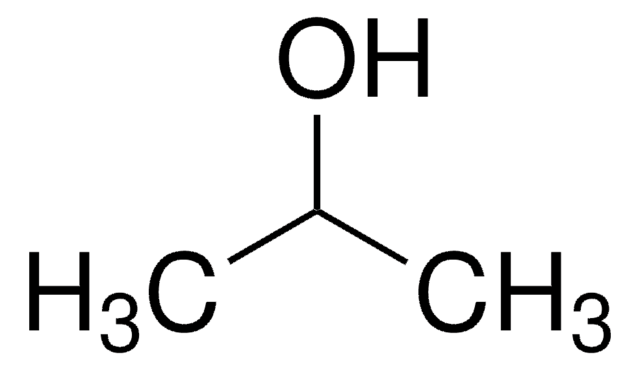673773
2-Propanol
≥99.5%, ACS reagent
Synonym(s):
isopropanol, sec-Propyl alcohol, IPA, Isopropanol, Isopropyl alcohol
About This Item
product name
2-Propanol, ACS reagent, ≥99.5%
grade
ACS reagent
Quality Level
vapor density
2.1 (vs air)
vapor pressure
33 mmHg ( 20 °C)
44 mmHg ( 25 °C)
assay
≥99.5%
form
liquid
autoignition temp.
750 °F
expl. lim.
2.0-12.7 %, 93 °C
impurities
≤0.0001 meq/g Titr. acid or base
≤0.002% carbonyl compounds (propionaldehyde or acetone)
≤0.2% water
evapn. residue
≤0.001%
color
APHA: ≤10
refractive index
n20/D 1.377 (lit.)
pH
7.0 (20 °C)
bp
82 °C (lit.)
mp
−89.5 °C (lit.)
solubility
H2O: passes test
water: soluble
density
0.785 g/mL at 25 °C (lit.)
SMILES string
CC(C)O
InChI
1S/C3H8O/c1-3(2)4/h3-4H,1-2H3
InChI key
KFZMGEQAYNKOFK-UHFFFAOYSA-N
Looking for similar products? Visit Product Comparison Guide
Related Categories
General description
Application
- As a solvent in the synthesis of di- and trisubstituted ortho biaryls by Suzuki-Miyaura cross-coupling reaction.
- As an alternate solvent to benzene in the analysis of total carbonyl compounds in heated and frying oils.
- As a reaction medium in the preparation of cyclic ureas by reacting CO2 with diamines in the presence of pure cerium oxide (CeO2).
signalword
Danger
hcodes
Hazard Classifications
Eye Irrit. 2 - Flam. Liq. 2 - STOT SE 3
target_organs
Central nervous system
wgk_germany
WGK 1
flash_point_f
closed cup
flash_point_c
closed cup
Certificates of Analysis (COA)
Search for Certificates of Analysis (COA) by entering the products Lot/Batch Number. Lot and Batch Numbers can be found on a product’s label following the words ‘Lot’ or ‘Batch’.
Already Own This Product?
Find documentation for the products that you have recently purchased in the Document Library.
Customers Also Viewed
Our team of scientists has experience in all areas of research including Life Science, Material Science, Chemical Synthesis, Chromatography, Analytical and many others.
Contact Technical Service


